
Identify green caterpillars
Nature does not make it easy for the hobby gardener when green caterpillars suddenly start eating on the lettuce. It can be the caterpillars of day and night moths as well as the larvae of hymenoptera such as sawfly. The body color is variable. There are yellow-green to black-green specimens and some shine in a poisonous neon green. Among the butterfly caterpillars there are mini specimens of a few millimeters or huge larvae that can be up to 15 cm long.
also read
- Biologically control caterpillars on tomatoes
- Which caterpillars endanger the eccentric
- Green flies in the apartment - species and control tips
Typical identifying features:
- Head : like the body or colored differently
- Hairiness : densely hairy caterpillars with long or short hair or hairless
- Drawing : with dots or stripes
- Excesses : spines or humps
- Pairs of legs : Butterflies with five to eight pairs of legs
Whites
The caterpillars from the white family are well camouflaged due to their green and brown color. Nevertheless, eye-catching drawings in warning colors can be seen to protect themselves from predators. Some species feed on poisonous plants and take over the toxic ingredients, so that the caterpillars are also poisonous for predators. White caterpillars have fully developed pairs of legs on their belly. They are hairy short or long, whereby the hairiness in some species is only developed in later caterpillar stages.
Large and small cabbage white butterfly - caterpillars in comparison
The caterpillars of the great cabbage white butterfly are initially light yellow in color and have a brown head. They molt four times and become progressively darker. Older caterpillars have a yellowish-colored body with black dots that are of different sizes and arranged in rows. Their head turns black and the body becomes increasingly hairy, while younger stages appear without hair.
In contrast, the caterpillars of the small cabbage white butterfly are dull light green with yellow stripes on the sides and on the back, which is typical of the species. Unlike the great cabbage white butterfly, this species does not undergo any significant change during its caterpillar development. All stages are covered with white hair and the coloration remains largely the same.
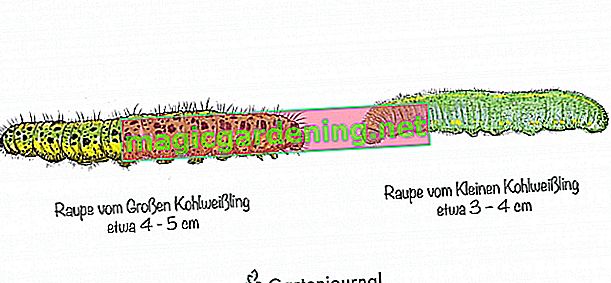
Enthusiast
Caterpillars with a sting on the rump look threatening. This outgrowth is the so-called anal horn, which is a typical distinguishing feature of swarmers. It sits on the eighth segment of the abdomen and in some species in the last stage can be strongly regressed to a button-shaped elevation.
| Main color of the thorn | different thorn color | Specialty | |
|---|---|---|---|
| Linden hawk | with blue sting | purple shimmer | triangular head capsule |
| Winch swarmers | with a red sting | partly orange nuances | Caterpillars up to 12 cm long |
| Privet fanatics | with black sting | colored light yellow at the base | with purple-white stripes on the sides |
| Pine hawks | Spines dark and split at the end | later reddish | with orange head |
background
Swarmers and their anal horn
The anal horn has no specific function. It is supposed to protect the caterpillars from predators, because such a sting is threatening to birds and other insect eaters. He pretends that the caterpillar is poisonous. However, the impressive caterpillars pose no danger to humans or pets.The bright colors of the sting in combination with the point and line drawing of many caterpillars intensify the threat. Even if the thorn regresses in the later caterpillar stage, the outgrowth continues to retain its deterrent function. As a button-shaped elevation, the thorn acts like a kind of eye.
Frost wrench
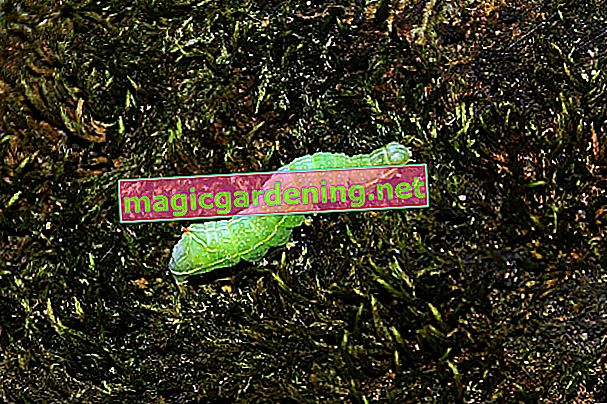
The caterpillars of these moths have a peculiar mode of locomotion, which is typical for all species in the family of the spanners. They differ from other butterfly species, which have four pairs of ventral feet, by one pair of ventral feet. In addition, tensioners have three pairs of breastbones and the so-called followers. To move, they cling to a branch with their breastbones and pull their abdomen up to their chest. This causes the body to bulge upwards in an omega shape. The caterpillar pushes itself forward with the help of its pushers and the pair of ventral feet.
Typical color of the caterpillars:
- adapted to the environment
- some species imitate small knots
- Little frost winder: light green with white stripes on the sides and dark lines on the back
- Large frost winder: red-brown with light spots
Food spectrum
The caterpillars of the large and small frost moth feed on young shoots, leaves and flower buds in spring. They attack fruit trees and do not stop at wild or ornamental shrubs. If the infestation is severe, the tree will corrode, leaving only the leaf veins and crumbs of excrement on the tree. As soon as the food is used up, the larvae look for other food sources. Therefore, green caterpillars can be observed in the spring, which can be driven to other trees with the wind.
Noble butterfly
Among the noble butterflies there are caterpillars with hairs or thorns that look threatening and fascinating at the same time. The thorns are simple or branchy. Your body drawing is very variable. The caterpillars can be provided with black stripes or with light and dark lines in different colors. Some species live gregariously on their forage plants.
This is what typical caterpillars look like:
- Small fox : black with two interrupted yellow side lines, yellow and black spines
- Monarch butterfly : ribbon pattern of white, black and yellow horizontal stripes
- Painted lady : light yellow to green-brown, dark pattern
- Forest board game : yellowish-green, dark green and white edged back stripes, laterally light and dark lines
Knight butterfly
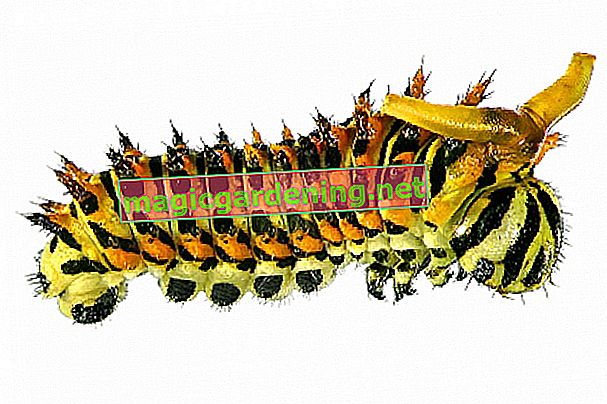
The brightly colored neck fork that sits between the head and body is typical of the caterpillars of knightly butterflies. In the event of danger, this can be turned out so that predators are deterred. To do this, the head and the front segments of the body are pulled down. The neck fork gives off an unpleasant odor.
Swallowtails belong to the knight butterfly family. Their caterpillars are initially black in color and have orange-red dots. The white saddle mark, which is supposed to remind of bird droppings, is typical. Older caterpillars are colored green and have black horizontal stripes with orange-red or yellow spots. Occasionally they occur in gardens when dill, carrots or fennel are grown there.
Caterpillars of other insects
Some larvae of other insects can easily be mistaken for caterpillars. There are green-colored sawfly caterpillars with a black head or yellow, brown and black stripes and with brown to black spots. Most of these caterpillars, however, are not harmful to the plants. They can be identified by their pairs of legs. In addition to the three pairs of sternum bones, these larvae develop up to four additional pairs of belly feet and a pair of legs at the end of the body, which is known as the follower.
Green caterpillars are not always the larvae of butterflies.
When can green caterpillars appear?
The months in which the caterpillars are active depends heavily on the weather conditions. In mild temperatures, the period of activity can expand. The caterpillars of various species of butterflies can sometimes be observed all year round. Many lettuce eaters can be observed more restricted. Their occurrence is concentrated in the summer months, when most of the forage plants grow.
| Main month | coloring | Identifying features | food | |
|---|---|---|---|---|
| Agate owl | March - October (- December) | green to yellow-brown | Back with a white line, interrupted | Nettle, blackberry, culinary herbs, lettuce |
| Gamma owl | March - October (- December) | green, yellowish or bluish | Black markings on the head | Nettle, dandelion, culinary herbs, lettuce |
| Little frost wrench | April June | green | white longitudinal lines | Shrubs |
| Pyramidal owl | May June | blue green | Humps on the abdomen | Oak, poplar, willow |
| Little cabbage white butterfly | August - October | light to pale green | yellowish side and back stripes, white pigments | Cabbage and vegetables, nasturtiums, rapeseed |
Fight green caterpillars?
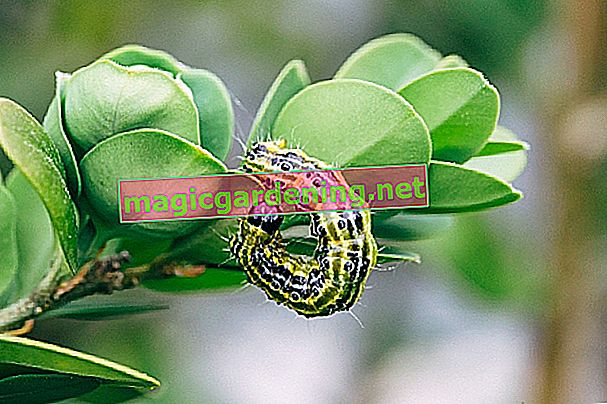
Whether control measures are necessary can only be determined after the exact species has been determined. Very few species are harmful to the plants in the garden and therefore do not have to be controlled. The caterpillars of the large and small frost moth or the boxwood moth are able to eat entire stands of plants. If the infestation is low, you can simply collect the caterpillars. Check your ornamental plants regularly to take further control measures if necessary.
Ornamental plants
The green caterpillars of the boxwood moth are dotted with black. They eat the leaves and bark of the boxwood until it is completely bare. Since the ornamental plant can be damaged, the caterpillars should be controlled early.
The light to dark green colored caterpillars of the hedgehog with a brown head eat like the caterpillars of the frost moth on roses. Orange-headed caterpillars come from sawfly.
If your lilac is infested with green caterpillars, it may be the privet hawk. The densely hairy caterpillars of the blue pelargonium settle on geraniums. These are yellow to green in color and have one or two pink longitudinal lines on the back.
vegetables and fruit
Various butterfly caterpillars can be found on kohlrabi, cauliflower or broccoli. In addition to the caterpillars of the common cabbage whites, green, brown or dark brown caterpillars of cabbage and vegetable owls can also feed on the plants. The greenish to yellow larva of the cabbage moth, which targets cabbages, is much more inconspicuous. Covering the plants with culture protection nets helps against the pests, so that the adult moths are prevented from laying eggs.
Other caterpillars in the kitchen garden:
- Strawberries: agate owl, borer or sawfly larvae
- Paprika: Owl butterflies like the vegetable owl
- Lettuce: gammaeule, frostworm
Tips
In order to recognize an infestation early on, you should search the earth for dung crumbs and eaten leaves. Usually the caterpillars do not show up at first glance.
trees and shrubs
In summer, green caterpillars are often active on fruit trees such as apple trees and cherry trees, which later develop into frost tensioners. These moths also affect shrubs such as currants and gooseberries. However, these fruit trees can also be visited by the caterpillars of the gooseberry sawfly. Regardless of whether it is frost-wrench or sawfly - the caterpillars can eat the woody plants completely bare and should be destroyed at an early stage.
It is completely different with the birch moth. The species is increasingly disappearing as its natural habitats are lost. Therefore, it is now on the pre-warning list. The pale green caterpillars are finely dotted with black and feed on the leaves of various birch plants. They occur not only on birch but also on black alder, hazel or winter linden.
Culinary herbs
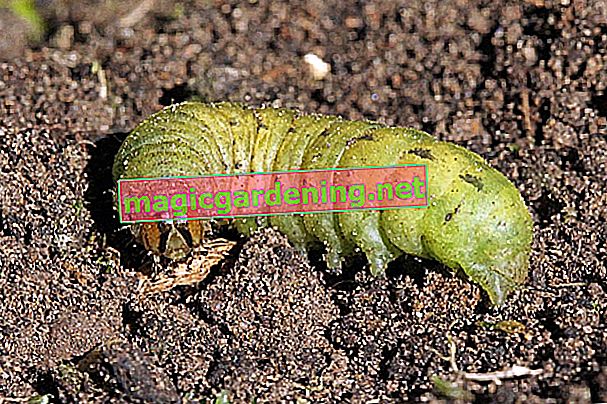
Owl butterflies have a wide range of foods. The species deal with almost all herbaceous plants. Gamma and agate owls are two of those species that can also be found on basil, mint, and parsley. Usually the well camouflaged caterpillars are difficult to spot. A good indication of a caterpillar infestation are small globules of excrement on the ground.
Tips
Since you still want to eat the culinary herbs, you shouldn't use soft soap, tobacco and the like. Instead, stick a clove of garlic in the ground.
frequently asked Questions
Are green caterpillars with thorns on their rump poisonous?
The spines that pine, linden or privet hawms develop on the abdomen are known as the anal horn. This serves to deter predators. In the course of development, the outgrowth can recede in some species, leaving an eye-shaped elevation behind. This thorn poses no danger to humans.
How can I fight green caterpillars naturally?
Safety nets are the simplest solution to prevent caterpillar infestation. These prevent the moths from laying eggs. If your plants are easily infested, you can simply collect the caterpillars. Release the captured animals in the forest so that they can look for alternative food crops.
If the infestation is more severe, you can spray robust plants and shrubs with a jet of water. Then collect fallen larvae from the ground. Caterpillars are guided by scents. Strong-smelling plants like garlic confuse the insect larvae. Mixed cultures therefore prevent caterpillar infestation.
How do I recognize an infestation by green caterpillars at an early stage?
Regardless of whether they are small, fat, large or long caterpillars - they all leave traces of food in the leaves. Examine your plants carefully and don't forget to check the undersides of leaves and branches. Many caterpillars are adapted to their environment and are therefore usually not visible at first glance. Dung crumbs are a good guide. They can be seen as dark spots on the plant.
When and where do green caterpillars appear?
The voracious larvae can appear in the garden from March to October, although their period of activity depends on the weather. In cold and rainy spring periods, the butterflies do not lay their eggs on the food plants until summer. If winter is delayed, offspring can be produced until December. Almost all plants in nature are infested by caterpillars. Many species have specialized, while other caterpillars are found on various ornamental and useful plants.








